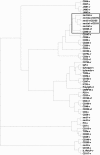A novel interface consisting of homologous immunoglobulin superfamily members with multiple functions
- PMID: 20081873
- PMCID: PMC4003259
- DOI: 10.1038/cmi.2009.108
A novel interface consisting of homologous immunoglobulin superfamily members with multiple functions
Abstract
Immunoglobulin superfamily (IgSF) members account for a large proportion of cell adhesion molecules that perform important immunological functions, including recognizing a variety of counterpart molecules on the cell surface or extracellular matrix. The findings that CD155/poliovirus receptor (PVR) and CD112/nectin-2 are the ligands for CD226/platelet and T-cell activation antigen 1 (PTA1)/DNAX accessory molecular-1 (DNAM-1), CD96/tactile and Washington University cell adhesion molecule (WUCAM) and that CD226 is physically and functionally associated with lymphocyte function-associated antigen-1 (LFA-1) on natural killer (NK) and activated T cells have largely expanded our knowledge about the functions of CD226, CD96, WUCAM and LFA-1 and their respective ligands, CD155, CD112, intercellular adhesion molecule (ICAM)-1 and junctional adhesion molecule (JAM)-1. The interactions of these receptors and their ligands are involved in many key functions of immune cells including naive T cells, cytotoxic T cells, NK cells, NK T cells, monocytes, dendritic cells, mast cells and platelets/megakaryocytes.
Figures





References
-
- Williams AF, Barclay AN. The immunoglobulin superfamily – domains for cell surface recognition. Annu Rev Immunol. 1988;6:381–405. - PubMed
-
- Available from: http://www.hlda8.org
-
- Reymond N, Fabre S, Lecocq E, Adelaide J, Dubreuil P, Lopez M. Nectin4/PRR4, a new afadin-associated member of the nectin family that trans-interacts with nectin1/PRR1 through V domain interaction. J Biol Chem. 2001;276:43205–43215. - PubMed
-
- Mueller S, Wimmer E. Recruitment of nectin-3 to cell–cell junctions through trans-heterophilic interaction with CD155, a vitronectin and poliovirus receptor that localizes to alphavbeta3 integrin-containing membrane microdomains. J Biol Chem. 2003;278:31251–31260. - PubMed
Publication types
MeSH terms
Substances
LinkOut - more resources
Full Text Sources
Other Literature Sources
Research Materials
Miscellaneous

